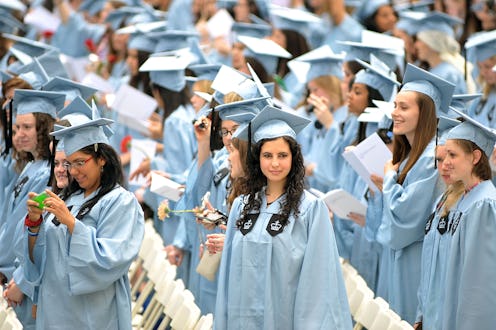Life
10 Things You Didn't Know About Women's Colleges
Before I discovered Barnard College late in my junior year of high school, I didn't realize that women's colleges still existed. Or, at least, that they were as progressive and empowering as they truly are. Because so few women in America choose to attend women's colleges (only 2 percent of female college students attend women's schools), misconceptions about them run rampant, and there are so many inspiring facts about women's colleges that people tend to overlook. I'm here to clear up a few of these myths.
When I told people I was attending a women's college at the end of my senior year, the reactions were unsurprising. Some people looked shocked and simply asked, "Why?" Others smirked and clarified, "Oh, you're going to an all-girls school?" No, I'm going to a women's college. Big difference. Then, from a select few people, came the stereotypes — "So do you hate men now?" No. But how does that relate to my college decision in the first place?
I didn't choose to attend Barnard because it was a women's college, but in my two years here I have realized the benefits of female-driven education. With a host of female professors and a tight-knit community of supportive women, my women's college experience has made me more educated about the three-dimensionality of feminism, ongoing issues of sexism, and most of all, how to work for and achieve my dreams in a patriarchal world. I've discovered that women's colleges breed open-mindedness and confidence in young women, giving them a dignified place in the world today.
Four years ago, I never imagined myself attending a women's college, but now that I'm here, I realize all of their benefits. Here are 10 things you may not have known about women's colleges — and hey, they may even convince you to attend one yourself.
1. They're Rare
There are only 48 women's colleges in the United States, out of the 4,000-plus colleges in the country. Many former women's colleges were dissolved in the latter 20th century, while others became co-educational. For example, Radcliffe College, the female counterpart to Harvard, began merging with Harvard in 1977. Vassar College was offered a merger with Yale University, but instead chose to go co-ed in 1969.
2. They're Not Convents
Men can be found on the campuses of women's colleges — and even in some of their classrooms. As a part of Columbia University, students at Barnard College are welcome to partake in all of the extra curricular activities and classes open to students at the university, and Columbia students are able to take classes at Barnard as well. Other women's colleges are members of multiple college consortiums; Mount Holyoke and Smith are a part of a Five College Consortium with Amherst College, Hampshire College, and the University of Massachusetts at Amherst, in which students of any school can take classes at another school in the consortium.
3. They Have Extremely Notable Alumnae
Despite the rarity of women's colleges today, a host of notable celebrities and academics all got their start through them. That includes Hillary Clinton (Wellesley), Meryl Streep (Vassar), Gloria Steinem (Smith), Katherine Hepburn (Bryn Mawr), Martha Stewart (Barnard), and more.
4. They Aren't All Religious
If your idea of a women's college is something akin to an all-girls Catholic high school, think again. Many women's colleges have no religious associations at all. In fact, none of the original Seven Sisters (Barnard, Bryn Mawr, Mount Holyoke, Radcliffe, Smith, Vassar, and Wellesley) have religious affiliations.
5. They Form Close Communities
Forget everything you've heard (or seen in movies) about girl hate and cliques. Female-driven environments don't encourage cattiness, but rather support camaraderie amongst ambitious, likeminded women.
6. They Drive Women to Traditionally Male-Dominated Fields
This isn't the 1950s. Women's colleges place heavy emphasis on STEM and other fields which are mostly male-dominated through initiatives and and academic support groups. Moreover, 20 percent of women in Congress graduated from women's colleges, despite the fact that only 2 percent of women in America choose to attend women's colleges.
7. They Support Female Professors and Academics
While academia is still a male-driven sphere, women's colleges encourage female academics by hiring and supporting female professors. At Barnard, women make up 65 percent of the 375 faculty members, giving students everyday examples of women in positions of power.
8. They Create Safe Spaces
While some argue that women's colleges create unrealistic environments for female students who live in a patriarchal society, women's schools work to create safe spaces that empower women to speak up for what they believe in. Students do not face gender-based discrimination in the classroom, and can flourish as they are.
9. They Are Gradually Becoming More Inclusive
After Mills College and Mount Holyoke recently released statements that they openly accept applications from transgender students, other women's colleges are coming to examine their own policies more closely, in order to become more accepting and to support all women.
10. They're Still Relevant in the 21st Century
Though the concept of a women's college may seem dated, in a society that continually proves itself to be sexist, women's colleges serve as bastions to educate and empower the female leaders of tomorrow. So long as women are treated differently from men, women's colleges will have a place in the world.
Images: InSapphoWeTrust, Susan Ujka's Collection, Mira (on the wall), Boston Public Library (3), Massachusetts Office of Travel & Tourism, WalkingGeek, Meagan, Curtis Cronn/Flickr
